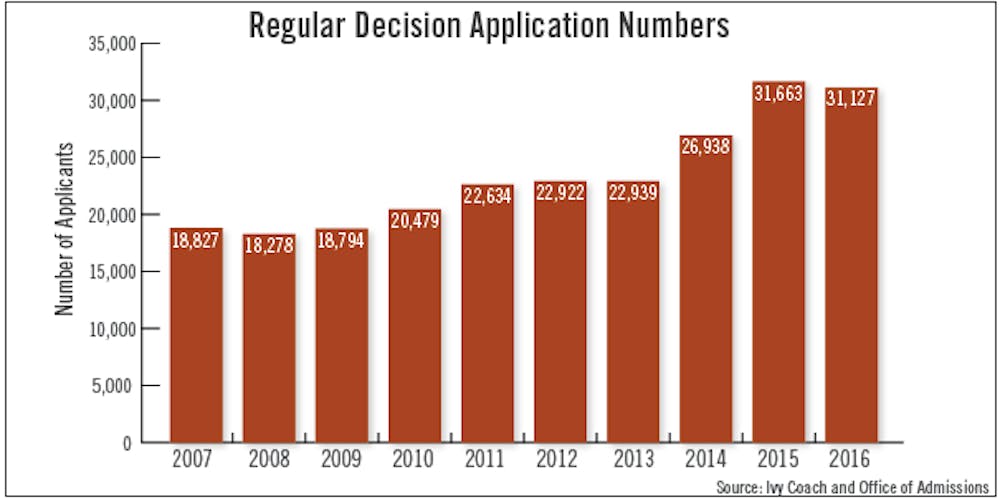
Though the early consensus by administrators and college counselors is that the reinstatement of early action programs at Harvard and Princeton universities contributed to a decline in Penn’s applicant pool, Dean of Admissions Eric Furda believes there may be more to the numbers than meets the eye.
On Tuesday, the Admissions Office reported that it had received a total of 31,127 applications this admissions cycle — a 1.7-percent decrease from last year’s total of 31,663.
While Furda acknowledged that the recent activity at Harvard and Princeton “definitely had an impact on the applicant pool,” he noted that this year’s slight drop may also be due to the plateau Penn reached last year when it “crested” the 30,000 application mark for the first time ever.
He added that the numbers may be “operating within a band” of 30,000 to 35,000 applications for several admissions cycles, just as they did in a band of 20,000 to 25,000 a few years ago.
He said he was not concerned with this year’s nearly 2-percent application decline, since it represented a fluctuation within his expected range.
Because Penn received fewer applications — along with the fact that the University’s early decision acceptance rate decreased by almost 1 percent from last year’s total — Furda predicted that the regular decision acceptance rate for the Class of 2016 may increase slightly.
“Given policy changes, given the shifting demographics, given adding an extra optional essay on the application and given the composition of the applicant pool from what I can see right now, I feel good about where we are right now,” he said. “That all being said, none of us are ever complacent.”
While most peer institutions have not yet reported application totals for the Class of 2016, Duke, Northwestern and Stanford universities recently announced that they had received 31,565, 31,500 and 36,744 applications, respectively.
These totals marked record highs for the schools.
Jeffrey Durso-Finley, director of college counseling at The Lawrenceville School in Lawrenceville, N.J., said that Penn may have seen more of an impact from the return of the early programs than Duke, Northwestern and Stanford because of the University’s geographic location.
“Once you get out of New England, a lot of those kids are interested in Northwestern and Stanford [rather] than in the East Coast,” he said.
IvySelect College Consulting Director Michael Goran, a 1976 College graduate, said the 1.7-percent decrease is not significant in light of the return of early action programs at the other schools.
“I think it’s a blip — it’s not substantial to a point where you need to worry about enrollment management or getting the word out,” he said.
For regular decision applicant Tuong Hoang — a senior at Carnegie Vanguard High School in Houston, Texas — the numbers were not surprising.
“A lot of my friends had been accepted to other Ivies [through early action], and it might have taken away some prospective applicants,” he said, adding that only a few of his friends are applying to Penn in the regular round as a result.
Regular decision applicant Arthur Bonnouvrier — a senior at Lycée Français de New York in New York — found hope in the smaller pool of regular decision applicants.
“I’m pretty happy,” he said. “All the applicants must be happy right now. It’s still a selective school, but it might improve [my chances] a little.”
The Daily Pennsylvanian is an independent, student-run newspaper. Please consider making a donation to support the coverage that shapes the University. Your generosity ensures a future of strong journalism at Penn.
DonatePlease note All comments are eligible for publication in The Daily Pennsylvanian.







